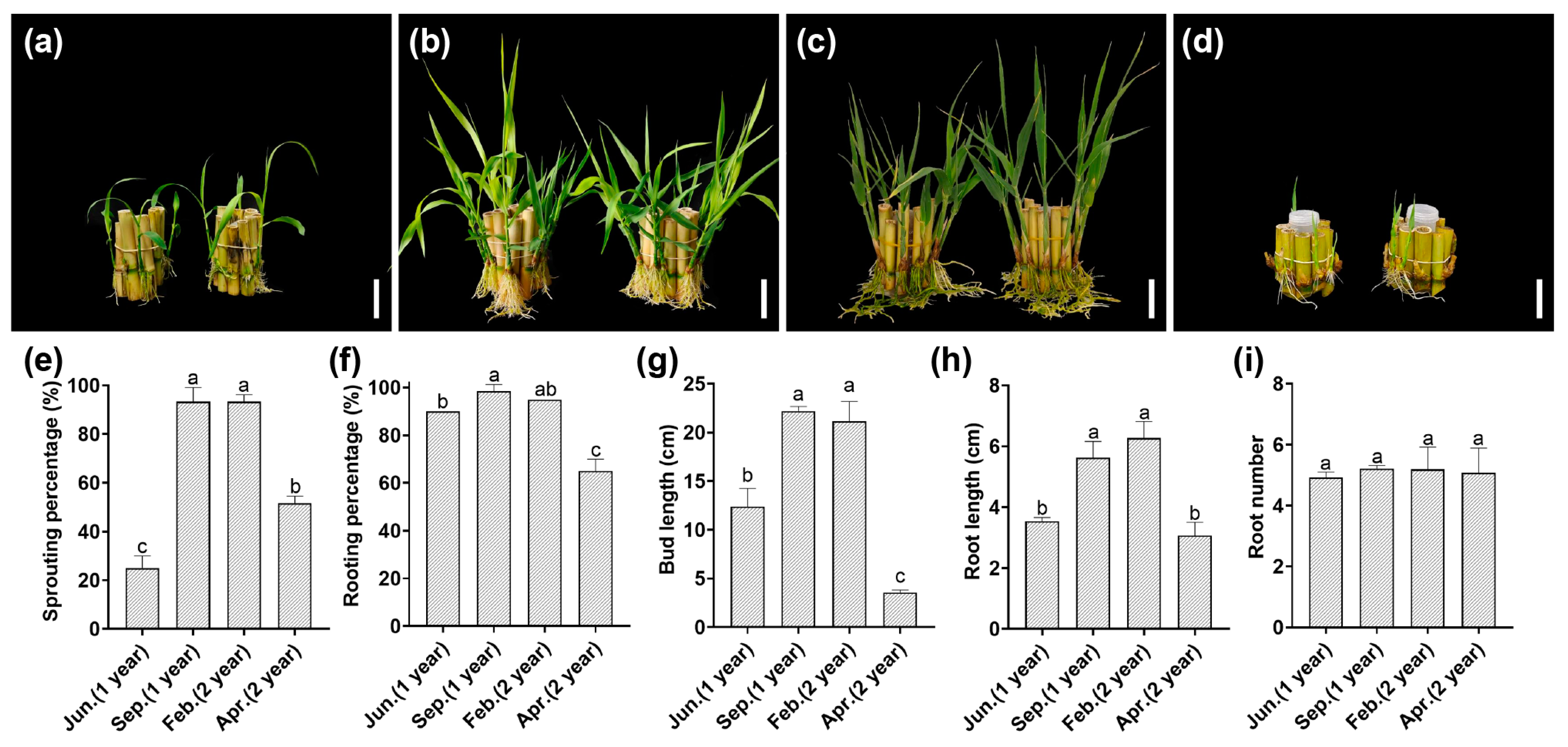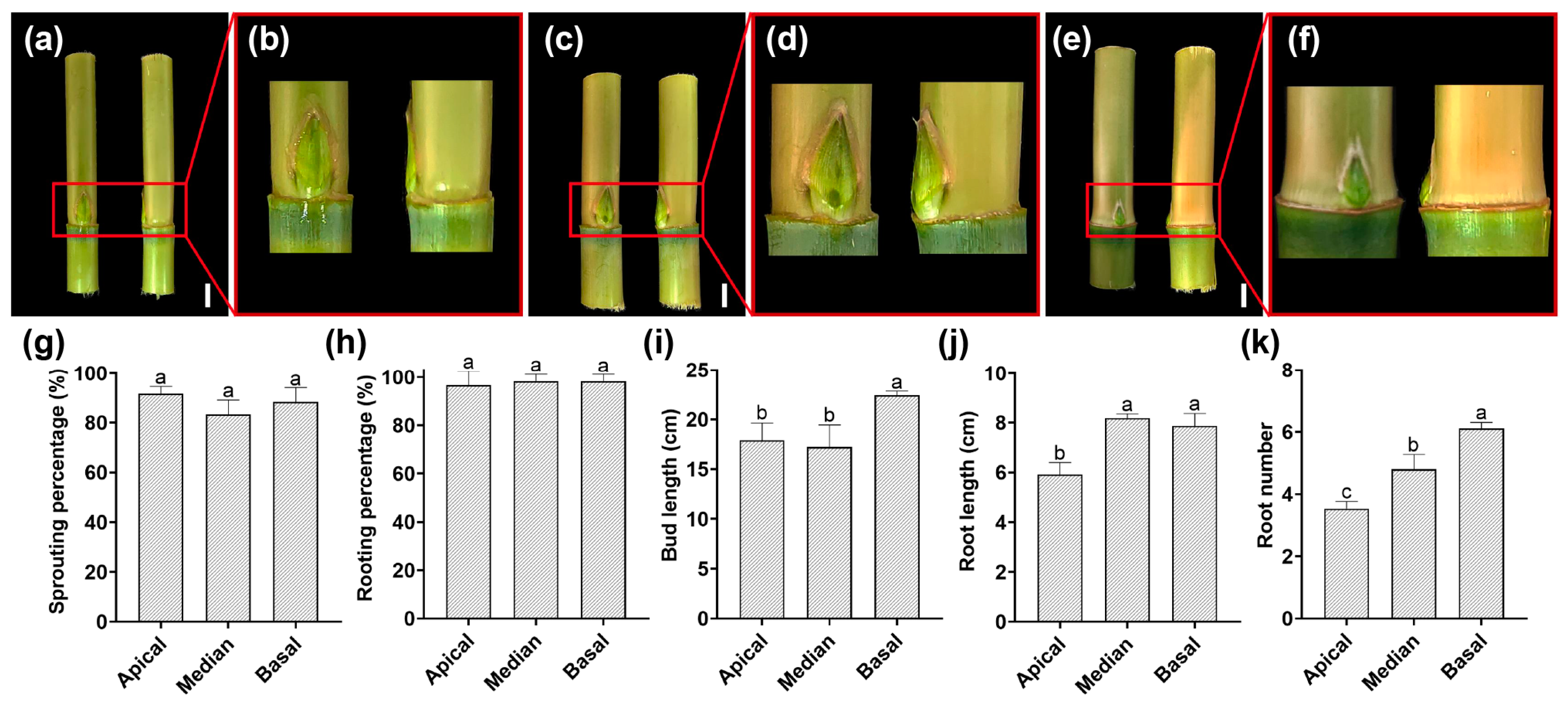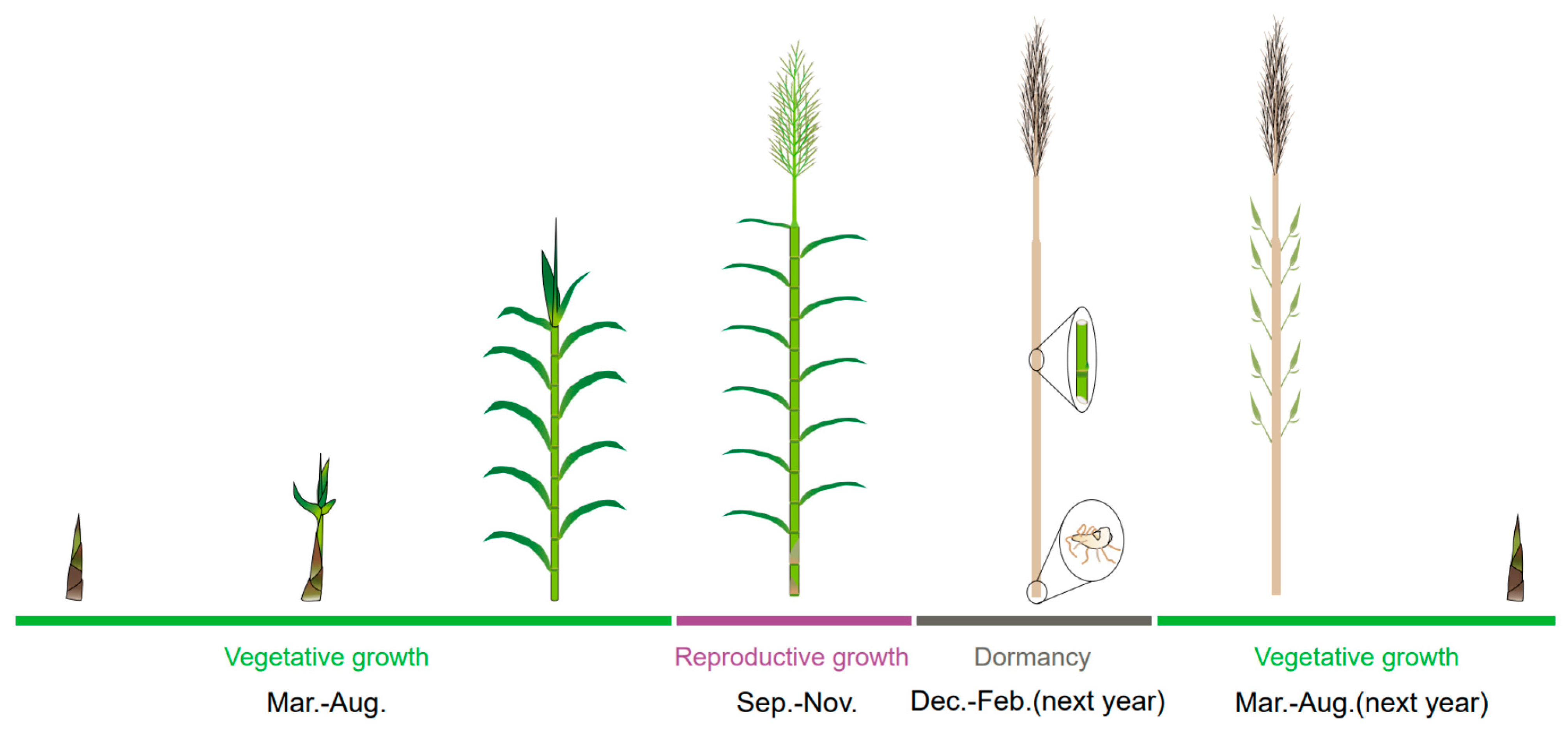An Efficient Aqua-Based Culture Method for the Propagation of High-Quality Arundo donax Seedlings
Abstract
1. Introduction
2. Materials and Methods
2.1. Plant Materials
2.2. Aqua-Based Culture
2.3. Cultivation and Acclimation
2.4. Statistical Analyses
3. Results
3.1. Effects of Rooting Powder Concentrations on Aqua-Based Culture
3.2. Effects of Sampling Months on Aqua-Based Culture
3.3. Effects of Cane Sections on Aqua-Based Culture
3.4. Effects of Growing Media on Cultivation and Acclimation
4. Discussion
5. Conclusions
Author Contributions
Funding
Data Availability Statement
Acknowledgments
Conflicts of Interest
References
- Cintura, E.; Faria, P.; Molari, L.; Barbaresi, L.; D’Orazio, D.; Nunes, L. Characterization of an Arundo donax-based composite: A solution to improve indoor comfort. Ind. Crop. Prod. 2024, 208, 117756. [Google Scholar] [CrossRef]
- Jiménez-Ruiz, J.; Hardion, L.; Del Monte, J.P.; Vila, B.; Santín-Montanyá, M.I. Monographs on invasive plants in Europe N° 4: Arundo donax L. Bot. Lett. 2021, 168, 131–151. [Google Scholar] [CrossRef]
- Hardion, L.; Verlaque, R.; Saltonstall, K.; Leriche, A.; Vila, B. Origin of the invasive Arundo donax (Poaceae): A trans-Asian expedition in herbaria. Ann. Bot. 2014, 114, 455–462. [Google Scholar] [CrossRef]
- Guarino, F.; Cicatelli, A.; Brundu, G.; Improta, G.; Triassi, M.; Castiglione, S. The use of MSAP reveals epigenetic diversity of the invasive clonal populations of Arundo donax L. PLoS ONE 2019, 14, e0215096. [Google Scholar] [CrossRef] [PubMed]
- da Costa, R.M.F.; Winters, A.; Hauck, B.; Martín, D.; Bosch, M.; Simister, R.; Gomez, L.D.; Batista de Carvalho, L.A.E.; Canhoto, J.M. Biorefining potential of wild-grown Arundo donax, Cortaderia selloana and Phragmites australis and the feasibility of white-rot fungi-mediated pretreatments. Front. Plant Sci. 2021, 12, 679966. [Google Scholar] [CrossRef]
- Danelli, T.; Laura, M.; Savona, M.; Landoni, M.; Adani, F.; Pilu, R. Genetic improvement of Arundo donax L.: Opportunities and challenges. Plants 2020, 9, 1584. [Google Scholar] [CrossRef]
- Pilu, R.; Cassani, E.; Landoni, M.; Badone, F.C.; Passera, A.; Cantaluppi, E.; Corno, L.; Adani, F. Genetic characterization of an Italian giant reed (Arundo donax L.) clones collection: Exploiting clonal selection. Euphytica 2014, 196, 169–181. [Google Scholar] [CrossRef]
- Bonanno, G. Arundo donax as a potential biomonitor of trace element contamination in water and sediment. Ecotox. Environ. Safe. 2012, 80, 20–27. [Google Scholar] [CrossRef]
- Perdue, R.E. Arundo donax—Source of musical reeds and industrial cellulose. Econ. Bot. 1958, 12, 368–404. [Google Scholar] [CrossRef]
- Sijimol, K.; Dev, S.A.; Sreekumar, V.B. A review of the ecological functions of reed bamboo, genus Ochlandra in the western ghats of India: Implications for sustainable conservation. Trop. Conserv. Sci. 2016, 9, 389–407. [Google Scholar] [CrossRef]
- Seawright, E.K.; Rister, M.E.; Lacewell, R.D.; McCorkle, D.A.; Sturdivant, A.W.; Yang, C.; Goolsby, J.A. Economic implications for the biological control of Arundo donax: Rio grande basin. Southwest. Entomol. 2009, 34, 377–394. [Google Scholar] [CrossRef]
- Allinson, G. Effect of increasing salinity on development of giant reed (Arundo donax) from rhizome and culms. Bull. Environ. Contam. Toxicol. 2017, 99, 743–747. [Google Scholar] [CrossRef] [PubMed]
- Docimo, T.; De Stefano, R.; De Palma, M.; Cappetta, E.; Villano, C.; Aversano, R.; Tucci, M. Transcriptional, metabolic and DNA methylation changes underpinning the response of Arundo donax ecotypes to NaCl excess. Planta 2020, 251, 34. [Google Scholar] [CrossRef] [PubMed]
- Shetty, R.; Vidya, C.S.; Vaculík, M. Comparison of the single and combined effects of arsenic and antimony on growth and physiology of giant reed (Arundo donax L.). Environ. Sci. Pollut. Res. 2021, 28, 55476–55485. [Google Scholar] [CrossRef]
- Angelini, L.G.; Ceccarini, L.; Di Nasso, N.N.O.; Bonari, E. Comparison of Arundo donax L. and Miscanthus x giganteus in a long-term field experiment in central Italy: Analysis of productive characteristics and energy balance. Biomass Bioenerg. 2009, 33, 635–643. [Google Scholar] [CrossRef]
- Dürešová, Z.; Šuňovská, A.; Horník, M.; Pipíška, M.; Gubišová, M.; Gubiš, J.; Hostin, S. Rhizofiltration potential of Arundo donax for cadmium and zinc removal from contaminated wastewater. Chem. Pap. 2014, 68, 1452–1462. [Google Scholar] [CrossRef]
- Idris, S.M.; Jones, P.L.; Salzman, S.A.; Croatto, G.; Allinson, G. Evaluation of the giant reed (Arundo donax) in horizontal subsurface flow wetlands for the treatment of dairy processing factory wastewater. Environ. Sci. Pollut. Res. 2012, 19, 3525–3537. [Google Scholar] [CrossRef]
- Li, L.; Yang, P.; Li, X.; Wen, Z.; Wang, J.; Yan, H. Comparison of nutritive value in different parts, height and silage time of Arundo donax. Acta Agrestia Sin. 2020, 28, 1168–1172. [Google Scholar]
- Greco, S.; Molari, L.; Valdrè, G.; Garcia, J.J. Multilevel analysis of six species of phyllostachys bamboo and Arundo donax: Preliminary survey on Italian grown stands. Wood Sci. Technol. 2024, 58, 1025–1049. [Google Scholar] [CrossRef]
- Maduro Dias, C.S.A.M.; Nunes, H.; Vouzela, C.; Madruga, J.; Borba, A. In vitro rumen fermentation kinetics determination and nutritional evaluation of several non-conventional plants with potential for ruminant feeding. Fermentation 2023, 9, 416. [Google Scholar] [CrossRef]
- Fiore, V.; Piperopoulos, E.; Calabrese, L. Assessment of Arundo donax fibers for oil spill recovery applications. Fibers 2019, 7, 75. [Google Scholar] [CrossRef]
- Manniello, C.; Cillis, G.; Statuto, D.; Di Pasquale, A.; Picuno, P. Concrete blocks reinforced with Arundo donax natural fibers with different aspect ratios for application in bioarchitecture. Appl. Sci. 2022, 12, 2167. [Google Scholar] [CrossRef]
- Vasmara, C.; Galletti, S.; Cianchetta, S.; Ceotto, E. Advancements in giant reed (Arundo donax L.) biomass pre-treatments for biogas production: A review. Energies 2023, 16, 949. [Google Scholar] [CrossRef]
- Verónica, C.; Alejandra, M.; Estela, S. Thermal behaviour and emission characteristics of Arundo donax L. as potential biofuel. Bioenerg. Res. 2023, 16, 1618–1628. [Google Scholar] [CrossRef]
- Liu, L.; Lin, Z.; Zheng, T.; Lin, L.; Zheng, C.; Lin, Z.; Wang, S.; Wang, Z. Fermentation optimization and characterization of the laccase from Pleurotus ostreatus stain 10969. Enzyme Microb. Technol. 2009, 44, 426–433. [Google Scholar] [CrossRef]
- Liu, Y.; Zhao, C.; Lin, D.; Lin, H.; Lin, Z. Effect of water extract from spent mushroom substrate after Ganoderma balabacense cultivation by using JUNCAO technique on production performance and hematology parameters of dairy cows. Anim. Sci. J. 2015, 86, 855–862. [Google Scholar] [CrossRef] [PubMed]
- Qiu, Y.; Lei, Y.; Zhao, H.; He, X.; Liu, B.; Huang, Y. Mesophilic anaerobic digestion of Arundo donax cv. Lvzhou No. 1 and Pennisetum giganteum for biogas production: Structure and functional analysis of microbial communities. Bioenerg. Res. 2023, 16, 1205–1216. [Google Scholar] [CrossRef]
- Speck, O. Field measurements of wind speed and reconfiguration in Arundo donax (Poaceae) with estimates of drag forces. Am. J. Bot. 2003, 90, 1253–1256. [Google Scholar] [CrossRef]
- Fagnano, M.; Impagliazzo, A.; Mori, M.; Fiorentino, N. Agronomic and environmental impacts of giant reed (Arundo donax L.): Results from a long-term field experiment in hilly areas subject to soil erosion. Bioenerg. Res. 2015, 8, 415–422. [Google Scholar] [CrossRef]
- Danelli, T.; Sepulcri, A.; Masetti, G.; Colombo, F.; Sangiorgio, S.; Cassani, E.; Anelli, S.; Adani, F.; Pilu, R. Arundo donax L. biomass production in a polluted area: Effects of two harvest timings on heavy metals uptake. Appl. Sci. 2021, 11, 1147. [Google Scholar] [CrossRef]
- Li, X.; Zhao, L.; Teng, Y.; Luo, Y.; Zhao, Q. Effects of cadmium on mercury accumulation and transformation by Arundo donax L. Environ. Sci. Pollut. Res. 2023, 30, 62461–62469. [Google Scholar] [CrossRef]
- Balogh, E.; Herr, J.M., Jr.; Czakó, M.; Márton, L. Defective development of male and female gametophytes in Arundo donax L. (Poageae). Biomass Bioenerg. 2012, 45, 265–269. [Google Scholar] [CrossRef]
- Dragoni, F.; Volpi, I.; Lwin, A.K.; Triana, F.; Tozzini, C.; Ragaglini, G. Comparing different propagation methods for giant reed (Arundo donax L.) across three years from planting. Biomass Bioenerg. 2021, 154, 106258. [Google Scholar] [CrossRef]
- Mariani, C.; Cabrini, R.; Danin, A.; Piffanelli, P.; Fricano, A.; Gomarasca, S.; Dicandilo, M.; Grassi, F.; Soave, C. Origin, diffusion and reproduction of the giant reed (Arundo donax L.): A promising weedy energy crop. Ann. Appl. Biol. 2010, 157, 191–202. [Google Scholar] [CrossRef]
- Ceotto, E.; Di Candilo, M. Shoot cuttings propagation of giant reed (Arundo donax L.) in water and moist soil: The path forward? Biomass Bioenerg. 2010, 34, 1614–1623. [Google Scholar] [CrossRef]
- Testa, R.; Foderà, M.; di Trapani, A.M.; Tudisca, S.; Sgroi, F. Giant reed as energy crop for southern Italy: An economic feasibility study. Renew. Sust. Energ. Rev. 2016, 58, 558–564. [Google Scholar] [CrossRef]
- Danelli, T.; Cantaluppi, E.; Tosca, A.; Cassani, E.; Landoni, M.; Bosio, S.; Adani, F.; Pilu, R. Influence of clonal variation on the efficiency of Arundo donax propagation methods. J. Plant Growth Regul. 2019, 38, 1449–1457. [Google Scholar] [CrossRef]
- Pilu, R.; Manca, A.; Landoni, M. Arundo donax as an energy crop: Pros and cons of the utilization of this perennial plant. Maydica 2013, 58, 54–59. [Google Scholar]
- Antal, G.; Kurucz, E.; Fári, M.G.; Popp, J. Tissue culture and agamic propagation of winter-frost tolerant ‘longicaulis’ Arundo donax L. Environ. Eng. Manag. J. 2014, 13, 2709–2715. [Google Scholar] [CrossRef]
- Bansal, S.; Sharma, M.K.; Joshi, P.; Malhotra, E.V.; Latha, M.; Malik, S.K. An efficient direct organogenesis protocol for in vitro clonal propagation of Rubia cordifolia L. Ind. Crop. Prod. 2024, 208, 117856. [Google Scholar] [CrossRef]
- Ozudogru, E.A.; Karlik, E.; Elazab, D.; Lambardi, M. Establishment of an efficient somatic embryogenesis protocol for giant reed (Arundo donax L.) and multiplication of obtained shoots via semi-solid or liquid culture. Horticulturae 2023, 9, 735. [Google Scholar] [CrossRef]
- Cavallaro, V.; Scordia, D.; Cosentino, S.L.; Copani, V. Up-scaling agamic propagation of giant reed (Arundo donax L.) by means of single-node stem cuttings. Ind. Crop. Prod. 2019, 128, 534–544. [Google Scholar] [CrossRef]
- Scordia, D.; Zanetti, F.; Varga, S.S.; Alexopoulou, E.; Cavallaro, V.; Monti, A.; Copani, V.; Cosentino, S.L. New insights into the propagation methods of switchgrass, miscanthus and giant reed. Bioenerg. Res. 2015, 8, 1480–1491. [Google Scholar] [CrossRef]
- Spencer, D.F.; Ksander, G.G. Estimating Arundo donax ramet recruitment using degree-day based equations. Aquat. Bot. 2006, 85, 282–288. [Google Scholar] [CrossRef]
- Wijte, A.H.B.M.; Mizutani, T.; Motamed, E.R.; Merryfield, M.L.; Miller, D.E.; Alexander, D.E. Temperature and endogenous factors cause seasonal patterns in rooting by stem fragments of the invasive giant reed, Arundo donax (Poaceae). Int. J. Plant Sci. 2005, 166, 507–517. [Google Scholar] [CrossRef]
- Bucci, A.; Cassani, E.; Landoni, M.; Cantaluppi, E.; Pilu, R. Analysis of chromosome number and speculations on the origin of Arundo donax L. (giant reed). Cytol. Genet. 2013, 47, 237–241. [Google Scholar] [CrossRef]
- Pilu, R.; Bucci, A.; Badone, F.C.; Landoni, M. Giant reed (Arundo donax L.): A weed plant or a promising energy crop? Afr. J. Biotechnol. 2012, 11, 9163–9174. [Google Scholar]
- Jiang, J.; Wang, Z.; Kong, X.; Chen, Y.; Li, J. Exogenous tryptophan application improves cadmium tolerance and inhibits cadmium upward transport in broccoli (Brassica oleracea var. italica). Front. Plant Sci. 2022, 13, 969675. [Google Scholar] [CrossRef]
- Chen, H.; Hong, L.; Ren, A.; Yu, K.; Wang, K.; He, S.; Liu, C.; Xing, J. Growth regulators on the shooting and rooting of Tamarix chinensis stem cuttings. Rhizosphere 2023, 25, 100679. [Google Scholar] [CrossRef]
- Sousa, D.L.D.; Santos, P.C.D.; de Sousa, M.B.; Nonato, E.R.L.; de Freitas, E.C.S.; Gallo, R. Growth regulators on shooting and adventitious rooting of Mimosa caesalpiniifolia adult stem cuttings. Rhizosphere 2024, 30, 100901. [Google Scholar] [CrossRef]
- Yuan, J.; Li, Y.; Luo, Y.; Yang, C.; Xuan, Y.; He, N. Effects of various types and concentrations of hormone on softwood cutting propagation of three fruit mulberry varieties. Sci. Seric. 2024, 50, 97–105. [Google Scholar]
- Quan, J.; Ni, R.; Wang, Y.; Sun, J.; Ma, M.; Bi, H. Effects of different growth regulators on the rooting of Catalpa bignonioides softwood cuttings. Life 2022, 12, 1231. [Google Scholar] [CrossRef]
- Sun, J.; Xia, J.; Zhao, X.; Su, L.; Li, C.; Liu, P. Effects of 1-aminobenzotriazole on the growth and physiological characteristics of Tamarix chinensis cuttings under salt stress. J. For. Res. 2021, 32, 1641–1651. [Google Scholar] [CrossRef]
- Chen, H.; Bi, S.; Ni, R.; Lei, Y.; Quan, J. Effects of different auxin and mass concentration on mulberry cutting rooting. J. Henan Agic. Univ. 2022, 56, 958–967. [Google Scholar]
- Xu, F.; Tian, Y.; Cheng, S.; Wang, F. Effect of ABT-1 rooting powder on rooting of Podocarpus nagi Cuttings. Guizhou Agric. Sci. 2014, 42, 112–114. [Google Scholar]
- Copani, V.; Cosentino, S.L.; Testa, G.; Scordia, D. Agamic propagation of giant reed (Arundo donax L.) in semi-arid Mediterranean environment. Ital. J. Agron. 2013, 8, 18–24. [Google Scholar]
- Fira, A.; Clapa, D.; Vescan, L.A. Direct ex vitro rooting and acclimation in blackberry cultivar ‘loch ness’. Bull. UASVM Anim. Sci. Biotechnol. 2012, 69, 247–254. [Google Scholar]
- Suzuki, N.; Miller, G.; Salazar, C.; Mondal, H.A.; Shulaev, E.; Cortes, D.F.; Shuman, J.L.; Luo, X.; Shah, J.; Schlauch, K.; et al. Temporal-spatial interaction between reactive oxygen species and abscisic acid regulates rapid systemic acclimation in plants. Plant Cell 2013, 25, 3553–3569. [Google Scholar] [CrossRef]





| Media Composition | Survival Rate (%) |
|---|---|
| Field soil:Nutritional soil:Vermiculite = 1:0:0 | 81.48 ± 1.85 b |
| Field soil:Nutritional soil:Vermiculite = 0:1:0 | 92.59 ± 1.85 a |
| Field soil:Nutritional soil:Vermiculite = 1:1:0 | 92.59 ± 3.70 a |
| Field soil:Nutritional soil:Vermiculite = 1:0:1 | 98.15 ± 1.85 a |
| Field soil:Nutritional soil:Vermiculite = 1:1:1 | 96.29 ± 1.85 a |
Disclaimer/Publisher’s Note: The statements, opinions and data contained in all publications are solely those of the individual author(s) and contributor(s) and not of MDPI and/or the editor(s). MDPI and/or the editor(s) disclaim responsibility for any injury to people or property resulting from any ideas, methods, instructions or products referred to in the content. |
© 2024 by the authors. Licensee MDPI, Basel, Switzerland. This article is an open access article distributed under the terms and conditions of the Creative Commons Attribution (CC BY) license (https://creativecommons.org/licenses/by/4.0/).
Share and Cite
Guo, J.; Li, W.; Cao, G.; Zhang, L.; Xie, Z.; Chen, W.; Shi, G.; Wei, F.; Tian, B. An Efficient Aqua-Based Culture Method for the Propagation of High-Quality Arundo donax Seedlings. Agronomy 2024, 14, 2047. https://doi.org/10.3390/agronomy14092047
Guo J, Li W, Cao G, Zhang L, Xie Z, Chen W, Shi G, Wei F, Tian B. An Efficient Aqua-Based Culture Method for the Propagation of High-Quality Arundo donax Seedlings. Agronomy. 2024; 14(9):2047. https://doi.org/10.3390/agronomy14092047
Chicago/Turabian StyleGuo, Jialin, Wei Li, Gangqiang Cao, Luyue Zhang, Zhengqing Xie, Weiwei Chen, Gongyao Shi, Fang Wei, and Baoming Tian. 2024. "An Efficient Aqua-Based Culture Method for the Propagation of High-Quality Arundo donax Seedlings" Agronomy 14, no. 9: 2047. https://doi.org/10.3390/agronomy14092047
APA StyleGuo, J., Li, W., Cao, G., Zhang, L., Xie, Z., Chen, W., Shi, G., Wei, F., & Tian, B. (2024). An Efficient Aqua-Based Culture Method for the Propagation of High-Quality Arundo donax Seedlings. Agronomy, 14(9), 2047. https://doi.org/10.3390/agronomy14092047






